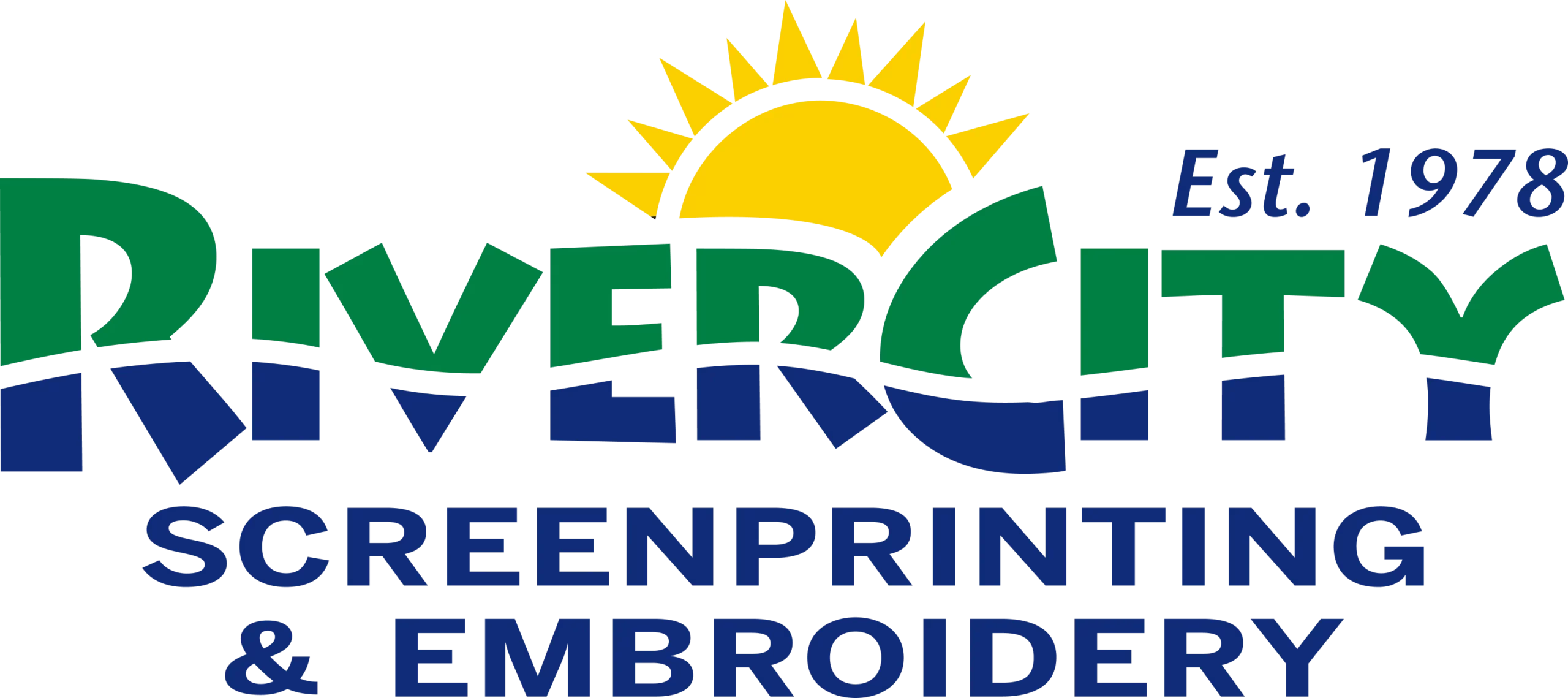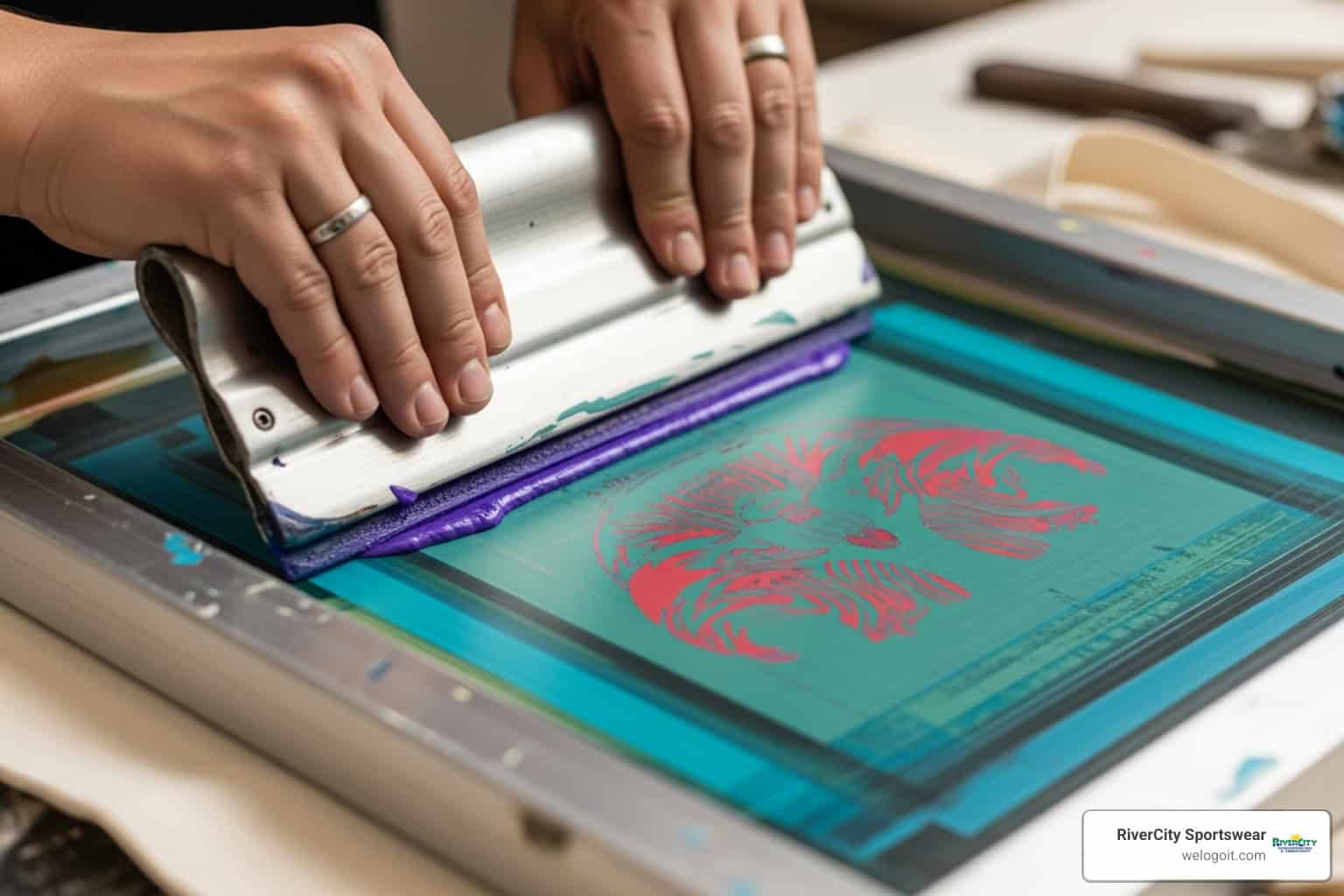Screen printed canvas bags is a fantastic way to create custom items. This method pushes ink through a prepared screen onto the fabric. It’s a popular choice for many reasons:
- Process: Ink is pressed through a mesh stencil directly onto the canvas. Each color in your design requires a separate screen.
- Durability: Screen printing creates long-lasting, vibrant designs that hold up well to wear and tear.
- Versatility: It works great for promotional items, unique DIY projects, and thoughtful personal gifts.
- Cost-Effective: For bulk orders, screen printing is often the most economical choice.
Canvas bags are useful everywhere. From carrying groceries to serving as promotional giveaways, they are a staple.
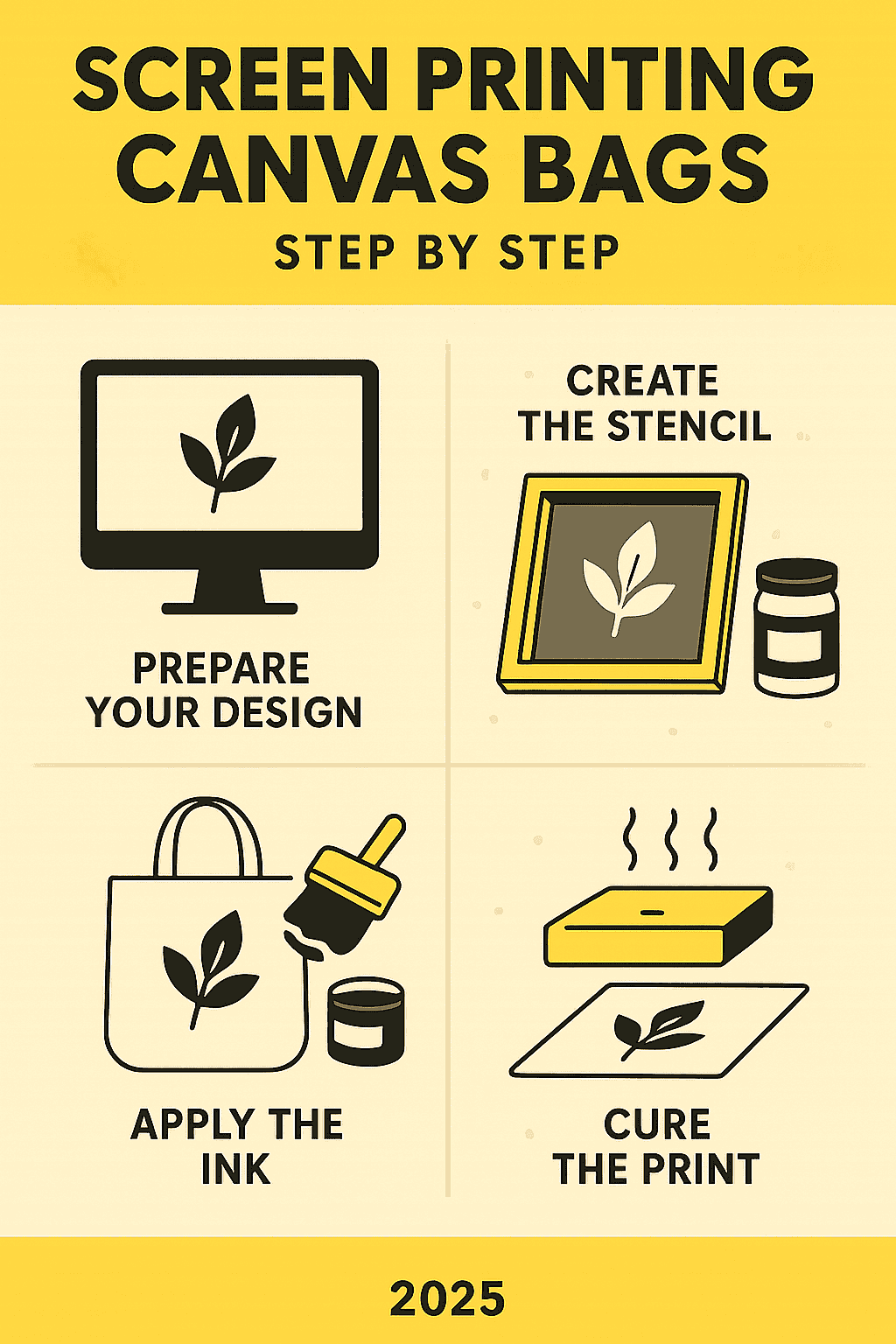
At its heart, screen printing is a stenciling method where ink is forced through a mesh screen onto a substrate like a canvas bag. This creates a vibrant, durable design that becomes part of the fabric. It’s a time-tested method that produces crisp, high-quality prints that withstand daily use. Understanding this process is key to achieving great results for your business, event, or personal project.
Getting Started
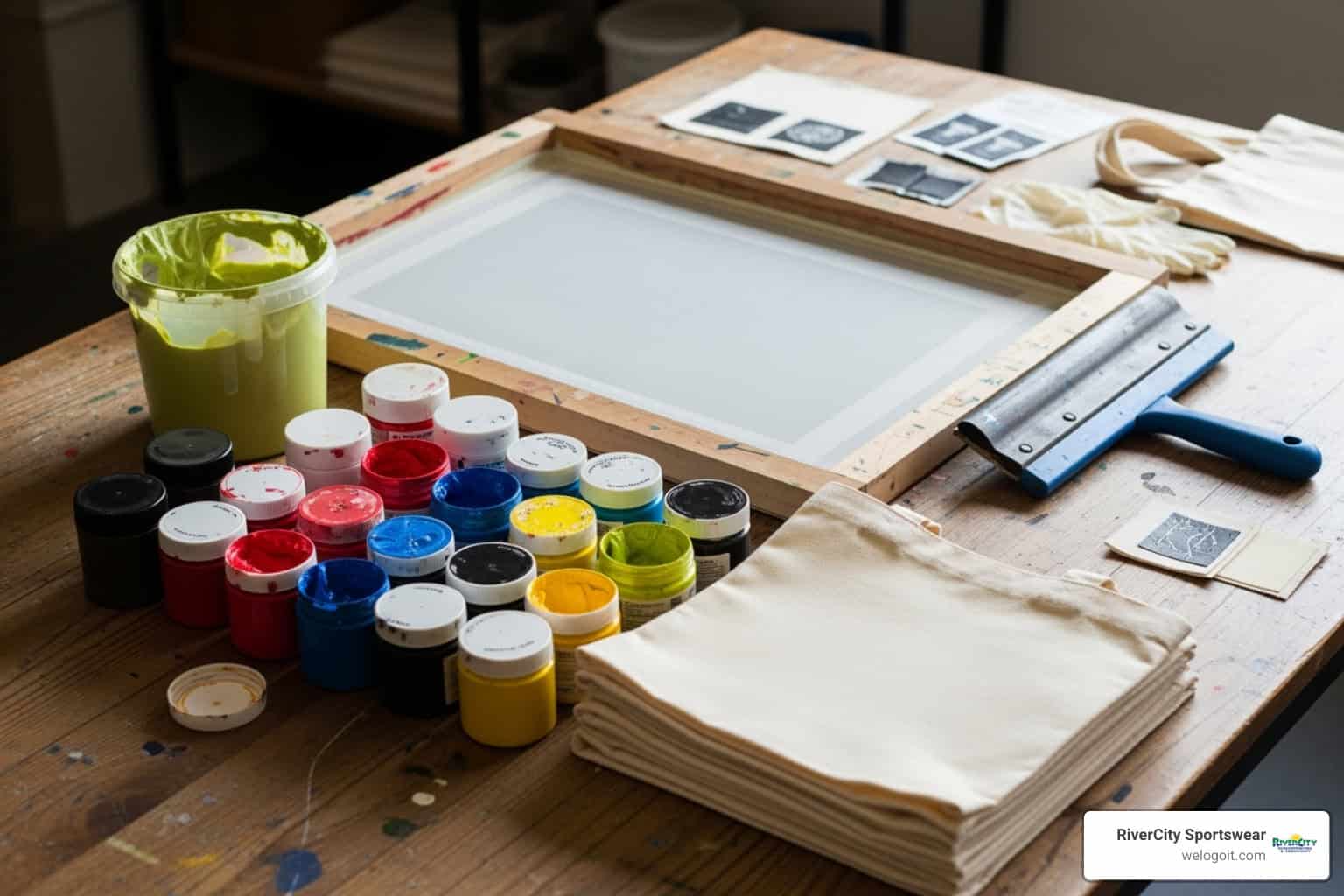
Proper prep makes the difference between a smooth process and a frustrating mess. With everything ready, the printing process itself is satisfying, as you watch your design come to life with each pull of the squeegee.
The three pillars of successful screen printing preparation are design preparation, workspace setup, and choosing the right materials. Each one builds on the others, creating a foundation for professional-quality results. For a comprehensive understanding of the fundamentals, check out our guide on How to Create and Prepare a Design for Screen Printing.
Choosing the Right Materials for Screen Printing Canvas Bags
Choosing the right bag material makes all the difference in your final product.
100% cotton canvas is the gold standard for screen printing. Cotton fibers have a natural affinity for ink, creating that perfect marriage between design and fabric that results in vibrant, long-lasting prints. Synthetic blends can work, but they often don’t hold ink as well or provide the same rich color saturation.
When it comes to fabric weight, you’ll typically encounter two main options. 6oz canvas offers a lighter, more flexible feel that’s perfect for promotional giveaways where cost is a consideration. It’s easy to fold and pack, making it ideal for events. On the other hand, 12oz canvas (around 320 gsm) strikes that sweet spot – it’s substantial enough to feel premium without being overly thick or rigid. This weight gives your bags a quality feel that recipients will actually want to use repeatedly.
Bag size and style choices are practically endless, but a popular standard size is around 40cm x 35cm (roughly 15.7″ x 13.8″). This versatile dimension comfortably holds books, groceries, or even a vinyl record collection! You can explore various styles from simple open-top totes to zippered versions, though keep in mind that additional features like zippers will increase your cost.
The choice between natural and colored canvas affects both your design approach and printing process. Natural, unbleached cotton canvas provides that eco-friendly, rustic appeal that’s so popular today. However, if you’re working with colored canvas – especially darker shades – you’ll likely need an underbase layer of white ink beneath your design. This acts like a primer, ensuring your colors pop vibrantly instead of being absorbed by the dark fabric underneath.
For more detailed guidance on material selection, our article on the Best Fabrics for Screen Printing dives deeper into these considerations.
Preparing Your Artwork for the Screen
Your artwork quality directly determines your print quality, so this step deserves your full attention.
Vector graphics are your best friend in screen printing. Created in programs like Adobe Illustrator, these files use mathematical formulas to define shapes and lines, meaning they can be scaled to any size without losing crispness. Raster images like JPEGs or PNGs, while fine for digital use, can become pixelated and blurry when enlarged for printing – and that pixelation will show up in your final print.
Understanding color separation is vital for screen printing canvas bags. Each color in your design requires its own separate screen, so your artwork needs to be broken down into individual color layers. This isn’t just a technical requirement – it’s what allows us to achieve precise registration and vibrant results.
Bold lines and simple designs are where screen printing truly shines. Designs with 1-2 solid colors often produce the most striking results and are the most cost-effective to produce. While some providers can handle up to 5 or even 7 colors, each additional color increases both complexity and cost.
Screen printing does have its design limitations, and understanding these upfront saves disappointment later. Complex gradients, intricate photographic details, or designs requiring dozens of colors aren’t ideal for this process. For those types of designs, other decoration methods might be more appropriate – and our team is always happy to guide you toward the best solution for your specific project.
Selecting the Best Inks
The ink you choose affects how your* canvas* bags look, feel, and last. Each type has its own purpose.
Plastisol inks are the workhorses of the screen printing world, and there’s good reason they’re so popular. These PVC-based inks sit on top of the fabric rather than soaking in, providing incredible opacity and vibrant colors even on dark fabrics. They’re fantastic for precise Pantone color matching, ensuring your brand colors are always spot-on. Plastisol inks also have excellent durability – they resist cracking and fading, and they have a long shelf life, making them very user-friendly for both beginners and professionals.
Water-based inks offer a completely different experience. These inks absorb into the fabric fibers, creating a much softer hand feel that integrates naturally with the canvas. Once cured, you can barely feel the print – it becomes part of the fabric itself. They work exceptionally well on 100% cotton materials, making them perfect for canvas bags where you want that natural, breathable feel. Many water-based inks are also formulated to be more environmentally friendly.
When printing on dark canvas bags with water-based inks, you’ll almost always need an underbase of white ink first. The transparency of water-based inks means they won’t show up vibrantly on dark backgrounds without this foundation layer.
For a comprehensive look at all your ink options, our guide on Different Types of Ink Used in Screen Printing covers everything you need to know.
The Step-by-Step Process for Screen Printing Canvas Bags
With prep work done, it’s time for the exciting part: bringing your vision to life on canvas. This is where the ink meets the fabric and your design shines.
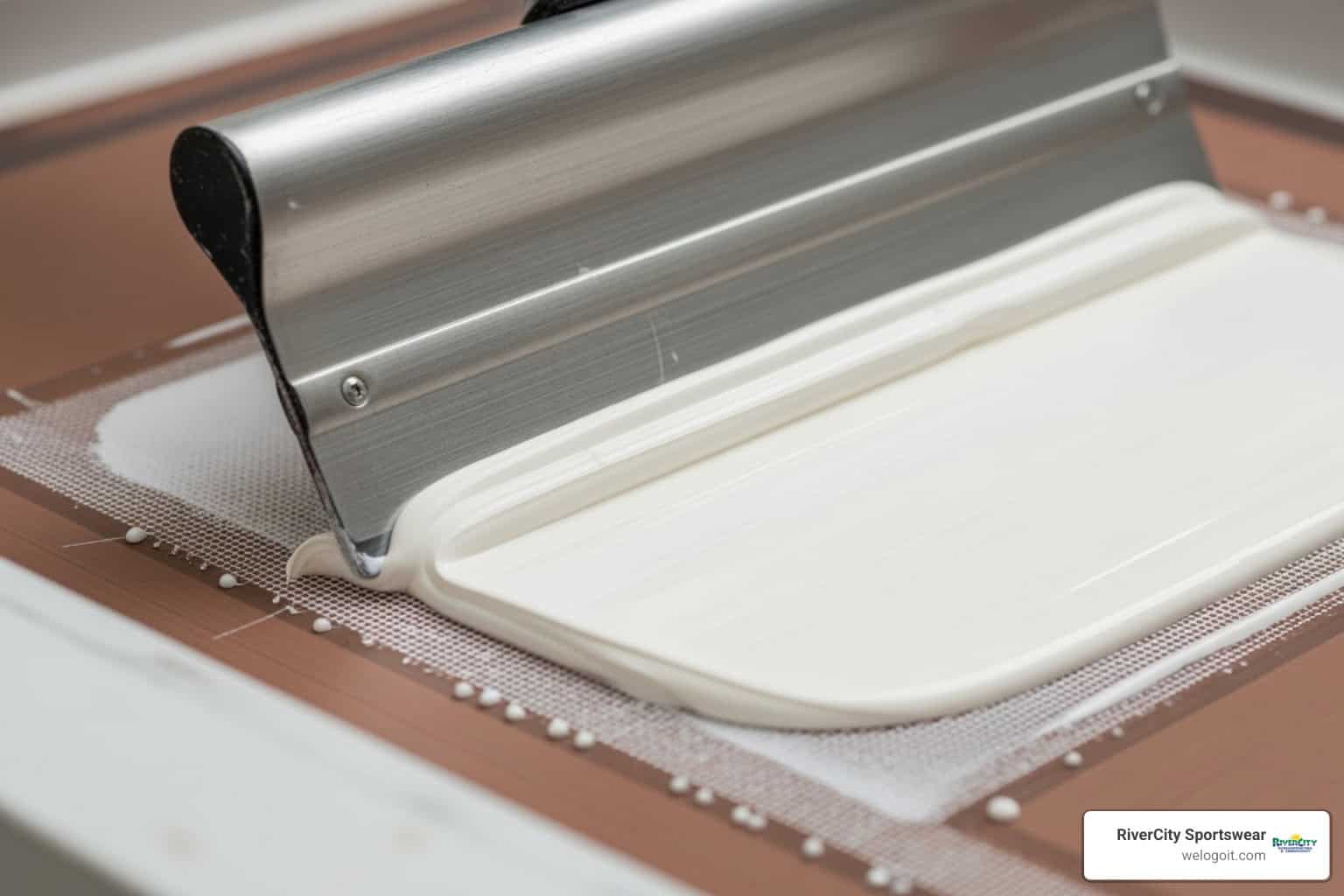
The journey of screen printing canvas bags involves a few key stages, each one building on the last. Don’t worry, we’ll walk through it together.
Step 1: Preparing and Exposing Your Screen
This is where your digital design becomes a physical, usable stencil.
First, the screen is coated with a light-sensitive emulsion. Once dry, your artwork (printed on a transparent film) is placed on the screen, which is then exposed to powerful UV light. The light hardens the emulsion everywhere except where the design blocks it.
Next is the washout process. The screen is sprayed with water, and the unhardened emulsion washes away, leaving a clear stencil for the ink. We check for imperfections to ensure a clean stencil, which is vital for flawless canvas bags.
Step 2: Setting Up Your Press and Printing
With the stencil ready, it’s time to set up the press and print.
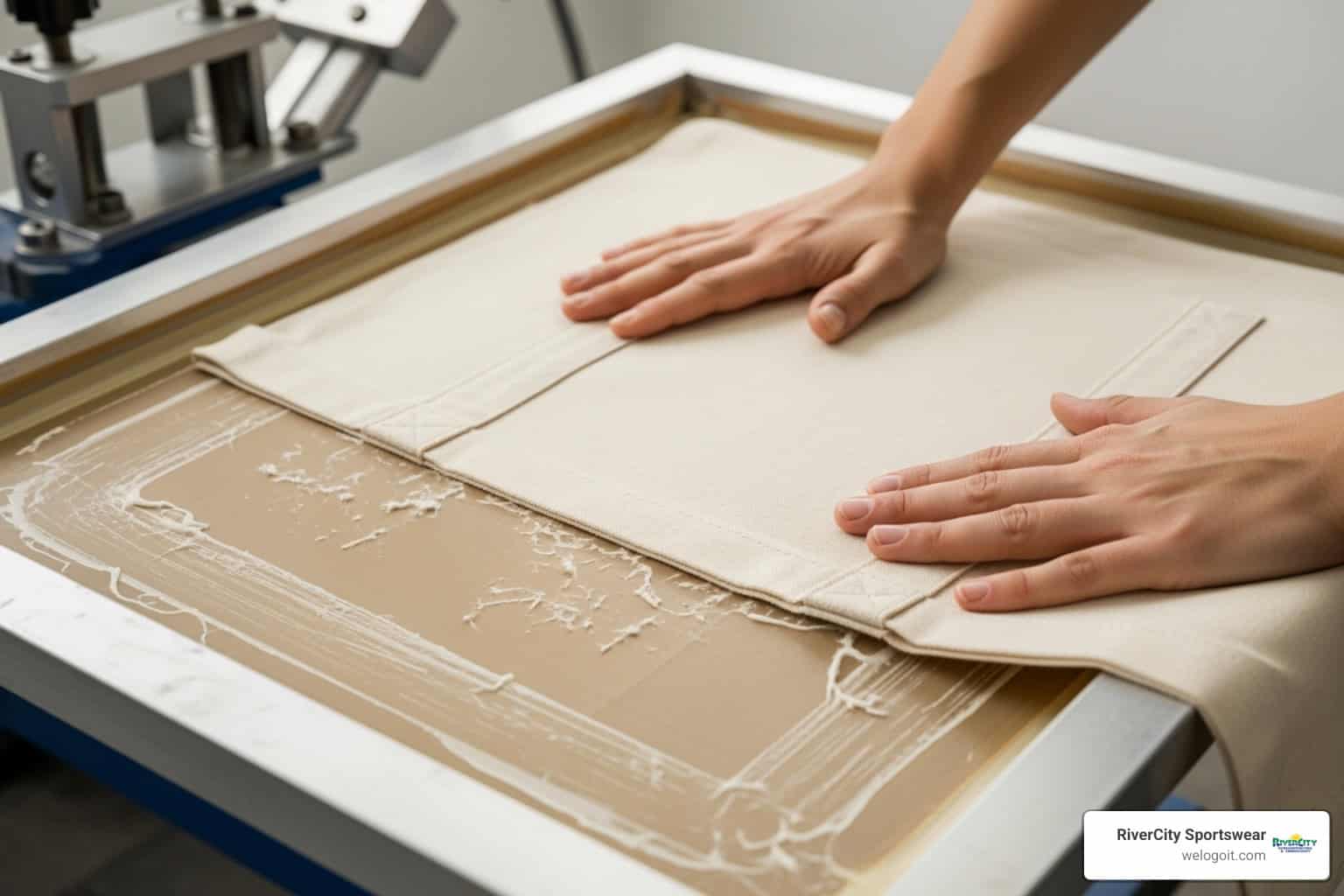
A super important trick for printing on fabric, especially canvas, is to use platen adhesive. We spray this sticky stuff onto the platen (that’s the flat surface where your bag sits). It holds your canvas bag securely in place, stopping any annoying shifting while you print. No wobbles means crisp lines!
Then, we carefully align each canvas bag on the platen. For multi-color designs, it’s crucial that every bag lands in the exact same spot so each color lines up perfectly. This is called “registration,” and it’s key to professional-looking canvas bags.
Now for the ink! We lower the screen onto the bag and scoop a line of ink along the top edge. Then, with our trusty squeegee, we “flood” the screen. This gently pushes the ink into all the open mesh areas of your stencil, getting it ready without pushing it through yet.
Finally, the moment of truth: the squeegee technique, or the “printing pull.” With steady, even pressure, we pull the squeegee firmly across the screen. This forces the ink right through those open stencil areas and onto your canvas bag. For a textured fabric like canvas, we often use a “double pass”. That means pulling the squeegee over the design twice. It helps ensure fantastic ink coverage and saturation, making your design really pop! Once the pull is done, we lift the screen, and voilà! Your design appears!
Want to know more about the rich history behind this incredible art form? Take a peek at A brief history of screen printing.
Step 3: Curing for a Durable, Long-Lasting Print
Your design is printed, but one crucial step remains: curing. Proper ink curing is essential to make your canvas bags last. This step makes the ink a permanent part of the fabric.
Curing uses heat to fully dry and bond the ink. For smaller, DIY projects, a heat gun can do the trick, though you need to keep it moving to avoid scorching. In a professional setting like ours, we use specialized equipment. A flash dryer might be used between color layers to quickly dry the ink to the touch, so we can add the next color without smudging.
For the final, complete cure, especially for larger batches, we rely on a conveyor dryer. Printed bags glide along a belt through a heated tunnel, ensuring every part of the ink reaches the precise temperature for the right amount of time. This guarantees a uniform and complete cure.
Why is proper curing so important? Because under-cured ink is the main reason prints crack, fade, or wash off. Each ink type has a specific temperature and dwell time it needs to hit to fully adhere to the canvas. This critical step ensures your bags are super durable, wash-fast, and ready for all your trips!
Pro-Tips for Flawless Results
After years of perfecting canvas bags, we’ve learned tricks that separate good prints from exceptional ones. These tips will transform your canvas bags from good to stunning.
The difference between a professional-looking print and an amateur one often comes down to the small details. Achieving crisp lines starts with proper screen tension – your screen should be as tight as a drum. A loose screen is like trying to write with a wobbly pen; you’ll never get clean results. Pair that taut screen with a sharp squeegee blade, and you’re already ahead of the game.
Avoiding ink bleed is another common challenge that trips up many beginners. The culprit is usually too much pressure or incorrect off-contact settings. Here’s where off-contact adjustment becomes crucial – that tiny gap (just a few millimeters) between your screen and the canvas bag before printing. When done right, the screen “snaps” cleanly off the bag after the squeegee pass, preventing smudging and ensuring sharp edges.
Always do test prints before starting your full batch. A quick test on scrap canvas can reveal registration or coverage problems, saving you from reprinting dozens of bags. Fixing one test print is much easier than redoing an entire order.
Cleaning and maintaining screens might not be the most exciting part of the process, but it’s absolutely vital. After each session, thoroughly remove all ink from your screens. Dried ink in the mesh is like a clogged drain – it’ll ruin everything. Store your clean screens in a dry, safe place where they won’t get damaged or dusty.
Speaking of dust, maintaining a clean workspace is non-negotiable. Even the tiniest speck of lint on your screen can create an unwanted mark on every single bag you print. A few minutes of cleanup can prevent hours of frustration later.
For businesses ready to take their custom merchandise to the next level with professional results, our team at RCSE brings years of expertise to every project. Check out our Promotional Products Services to see how we can help bring your vision to life with flawless execution.
Why Screen Printing is the Top Choice for Canvas Bags
When it comes to decorating canvas bags, screen printing often emerges as the clear winner. After years of working with clients across Texas, I can tell you that this method consistently delivers results that make both businesses and customers happy.
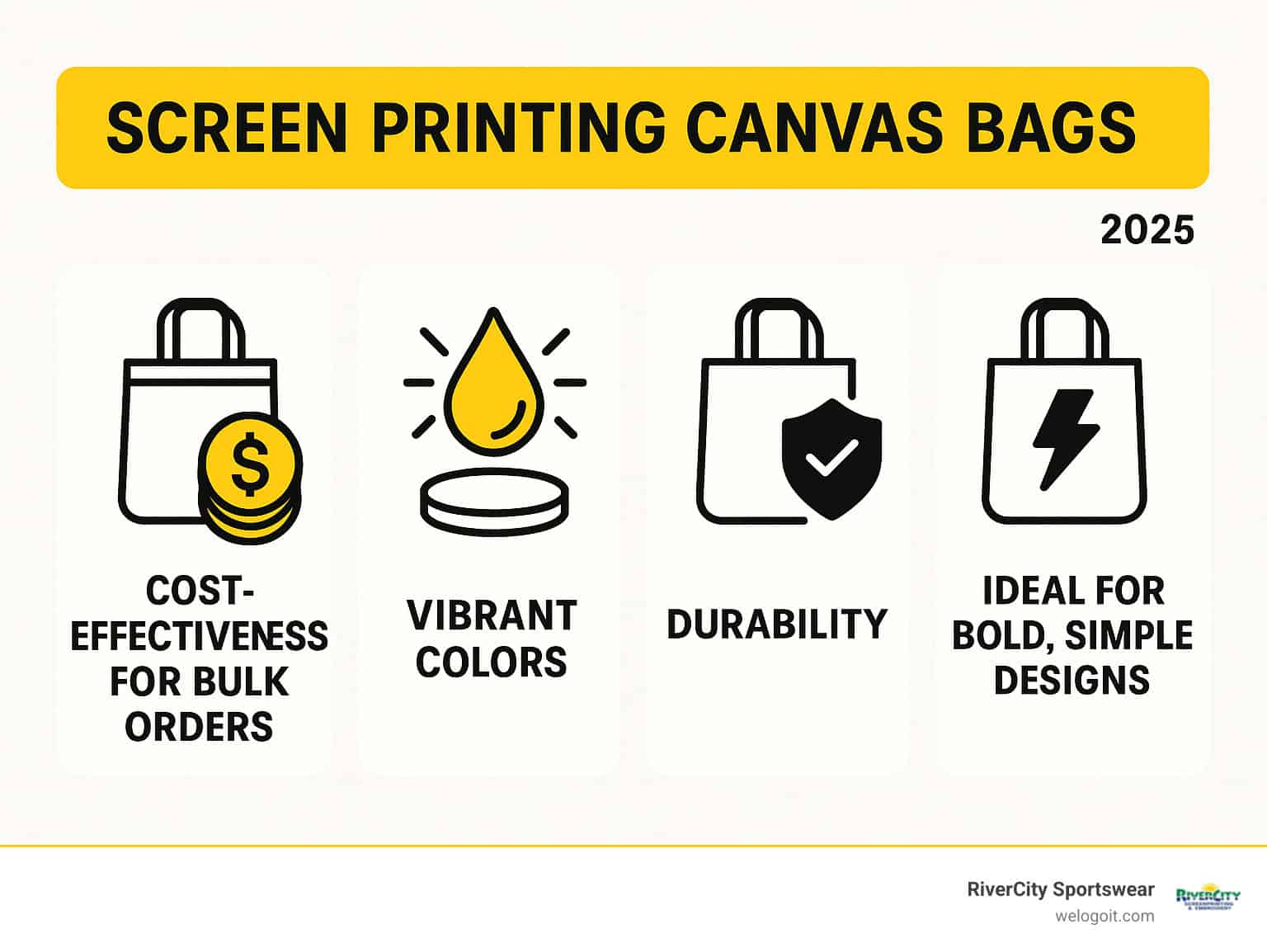
The cost-effectiveness for bulk orders is probably what gets most people’s attention first. Once we’ve set up your screens, each additional bag becomes remarkably affordable. We often see significant price breaks starting at just 24 pieces, with typical minimums ranging from 12 to 50 pieces per design. This makes it perfect for everything from company events to retail merchandise.
But it’s not just about saving money. The vibrant colors you get with screen printing are honestly hard to beat. Those plastisol inks sit right on top of the canvas, creating colors that practically jump off the bag. Even on darker canvas, your design will pop with incredible clarity and brightness.
Durability is where screen printing really shines, though. When we properly cure those inks, they become part of the fabric itself. Your bags will go through countless washes, trips to the grocery store, and daily use while looking as fresh as the day they were printed. That’s the kind of lasting quality that makes your investment worthwhile.
Screen printing is ideal for bold, simple designs – think crisp logos, catchy slogans, and clean graphics. If your design features solid colors and clear lines, you’re in the sweet spot for this method. It’s why so many successful promotional campaigns rely on screen printing for their canvas bags.
You can learn more about selecting the perfect promotional items in our guide on Choosing the Right Promotional Product.
Limitations of Other Methods on Canvas
While other decoration methods have their place, they often fall short when it comes to canvas bags. Sublimation works beautifully for full-color photographic prints, but it needs high-polyester content fabrics to work properly. Since the best canvas bags are made from 100% cotton for that natural feel and durability, sublimation just isn’t compatible.
Digital printing (DTG) excels at intricate, multi-color designs and can handle photographic details wonderfully. However, it becomes less cost-effective for large orders, and achieving vibrant colors on dark fabrics often requires additional steps that screen printing handles more efficiently.
Heat transfer vinyl (HTV) is fantastic for small batches and personalized items. But on canvas bags, especially larger designs, it can feel stiff and plasticky. It also doesn’t integrate with the fabric the way screen printing does, which can affect both comfort and longevity.
These limitations are exactly why canvas bags made from natural cotton remains our go-to recommendation for most projects.
When to Consider a Different Approach
If your design requires full-color photographic images or is extremely intricate and one-off, contact our team for advice on the best decoration method for your project.
Frequently Asked Questions about Screen Printing Totes
What designs work best for screen printing on canvas?
For canvas bags, simple designs with 1-5 colors work best. Bold shapes, crisp lines, and clear text built with vector graphics produce the sharpest results.
Why is this? Well, screen printing works by pushing ink through a mesh stencil. The texture of canvas, while lovely, can be a little rough. This means super fine details, tiny gradients, or realistic photographic images can sometimes get a bit lost or not look as crisp as you’d hope. If your art is more complex, other decoration methods might be a better fit. Our team at RiverCity Sportswear can guide you to the perfect solution for your artwork.
How do I care for my canvas bag?
Proper care is important for keeping your custom canvas bags looking vibrant.
To keep your bag in top shape, turn it inside out before washing. Use cold water and a gentle cycle. Hot water can cause the ink to fade or crack.
For drying, air drying is best. If using a dryer, pick a low heat setting, as high heat can cause damage. If you need to iron your bag, don’t iron directly over the printed area. Turn the bag inside out or place a thin cloth over the design to protect it. Following these steps will help your custom screen printed canvas bags last.
What is a typical minimum order for custom printed bags?
The answer depends on your project.
Professional services have minimum order quantities (MOQs). This is due to the upfront work of creating screens, mixing inks, and setting up the press, which costs the same regardless of order size.
Because of these setup costs, it’s more cost-effective to print a certain number of items. MOQs can vary, but professional services often start around 12 to 24 pieces. For more complex designs, the minimum might be around 50 pieces per design. The good news is that larger orders significantly reduce the cost per bag. You’ll see price breaks as your quantity increases because the setup costs are spread over more items. We can provide transparent pricing for your project.
Bring Your Canvas Bag Vision to Life
We hope this guide has helped you understand screen printing canvas bags. You now have the knowledge to create stunning, durable custom bags.
The beauty of screen printing lies in its versatility. Whether you’re a weekend warrior wanting to create a few personalized totes for your book club or a business owner looking to spread brand awareness at the next trade show, this time-tested method delivers. The vibrant colors, exceptional durability, and cost-effectiveness for larger orders make it a smart choice that keeps giving back.
For those DIY projects, we encourage you to dive in! Start simple with a bold one-color design, practice your squeegee technique, and don’t forget those test prints. Every expert was once a beginner, and there’s something deeply satisfying about pulling that squeegee and seeing your design come to life on canvas.
Sometimes you need the pros. For tight deadlines, large orders, or a perfect finish that comes with experience, expert help is key. For complex designs, precise color matching, or the peace of mind of professional quality, our team can help.
RCSE offers screen printing services that take the guesswork out of your custom printing needs. With over 15 years of experience serving San Marcos, Austin, and across Central and South Texas, we’ve perfected the art of creating “tote-ally” awesome bags. Our commitment to exceptional customer service, fast turnaround times, and personalized design support means your vision becomes reality without the stress.
Ready to transform your ideas into beautiful, functional canvas bags? Whether it’s 12 pieces or 1,200, we’re here to make it happen. Get a quote for your custom screen printing project today, and let’s create something amazing together!
